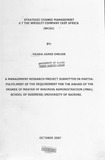| dc.description.abstract | In the face of newly emerging dynamics in the business environment, organizations are increasingly feeling compelled to implement strategic changes to better adapt to evolving environmental challenges. Similarly, the Wrigley Company East Africa Limited had faced challenges some of which were global competition technological advancement and changes in consumer tastes and preferences. In response to these challenges, the company undertook major changes to its operations. The purpose of this study was to investigate what changes the Wrigley Company implemented and how the change was implemented. Further the study sought to establish what the challenges to the change initiatives were. In this study, a case study approach was adopted on the Wrigley Company (EA) Ltd as an organization. The study sought to document in detail the strategic change management that the company undertook in response to environmental conditions. A case study was used because it is a powerful form of qualitative analysis that involves a careful and complete observation of a social unit (Young 1960, Kothari 1990). The study collected primary data from respondents through a semi structured interview guide. The interviews were administered on twenty four respondents who included two directors of the company, three senior managers, four middle managers, eight power users, and three lead change managers. Four other-employees from supply chain and commercial units were also interviewed. Secondary data was collected from records within the company's offices and its website. The data was qualitative in nature. Content analysis technique was used to analyse the data. In this technique, inferences from study findings were made by systematically and objectively identifying specified characteristics of messages (Nachmias and Nachmias 1996) Findings indicated that the main initiator of changes that were implemented at WCEA was the Wrigley global head office in Chicago. Key among the changes that occurred within WCEA as an organization included, structural changes from the previous departmental functions to main units of commercial and supply chain. Within the two units there was internal restructuring to enable alignment of the new systems to these structures. Administratively however, some employees moved to new process areas. Technological aspects of the company's operations included integration across process areas, improved integrated use of systems applications and products (SAP) based on enterprise resource planning (ERP), and enhanced use of systems. Everybody at WCEA subsequently had an account in SAP for reports and information. Changes in the company's processes included the creation of three main process areas namely forecast to stocks (FTS), order to cash (OTC), and finance (FIN). Information transfer became faster and there was better understanding of value chain among employees. Various approaches and procedures were used to implement the new changes at WCEA. To improve the competence and technical capacities of WCEA employees, and to contribute meaningfully to the change process, initial trainings by consultants were organized. There were also infrastructural enhancements that included the upgrading of information technology (IT) systems like replacement of old slow computers with faster ones. This was accompanied by training of employees on IT skills to enable them understand advantages of networked systems, and the contribution of the new processes and procedures to the overall efficiency of the organization. Avenues used to communicate the change process to the company staff included bulletins, memos, face to face meetings with supervisors, open day meetings and audio-visual materials. The change process at WCEA was however confronted by both systemic and behavioural forms of resistance. The rampant systemic resistance was drawing from widespread staff incompetence at executing IT related tasks owing to inadequate training. Behavioral resistance on the other hand was fanned by the senior managers who appeared not to trust the process as they were comfortable with the status quo. Part of the reason that change objectives were yet to be realized at WCEA was because of the general indifference from senior staff and managers who felt their powers under the old system being faced out would be muzzled by the new structures the new system was creating. Based on these findings, it is therefore recommended that further training to employees at WCEA, including power users (PUs) and end users (EUs) to enhance their understanding of and competence at handling the new systems and process be done. This would go along way in overcoming systemic resistance to the new changes implemented. WCEA further needed to carry out a Cost Benefit Analysis (CBA) to quantify the actual cost of the changes effected and the economic value of the benefits the change has attracted to the company, an under taking that would enable the company determine the level of cost effectiveness of its changes. | en |

